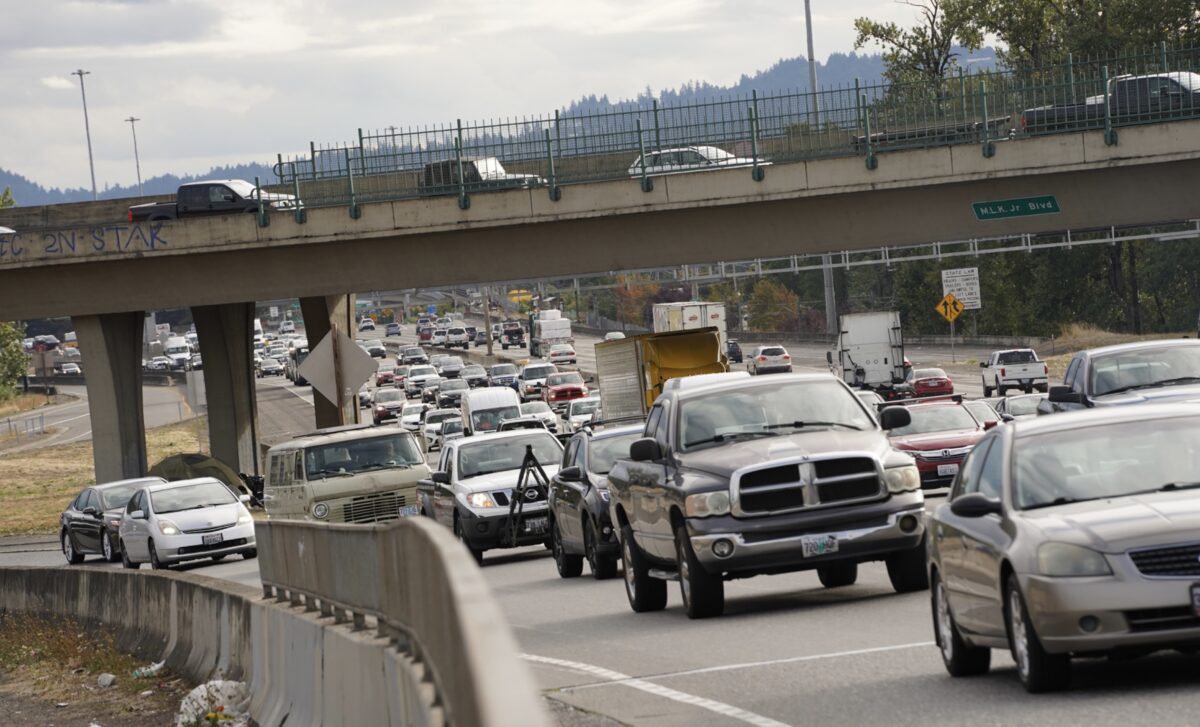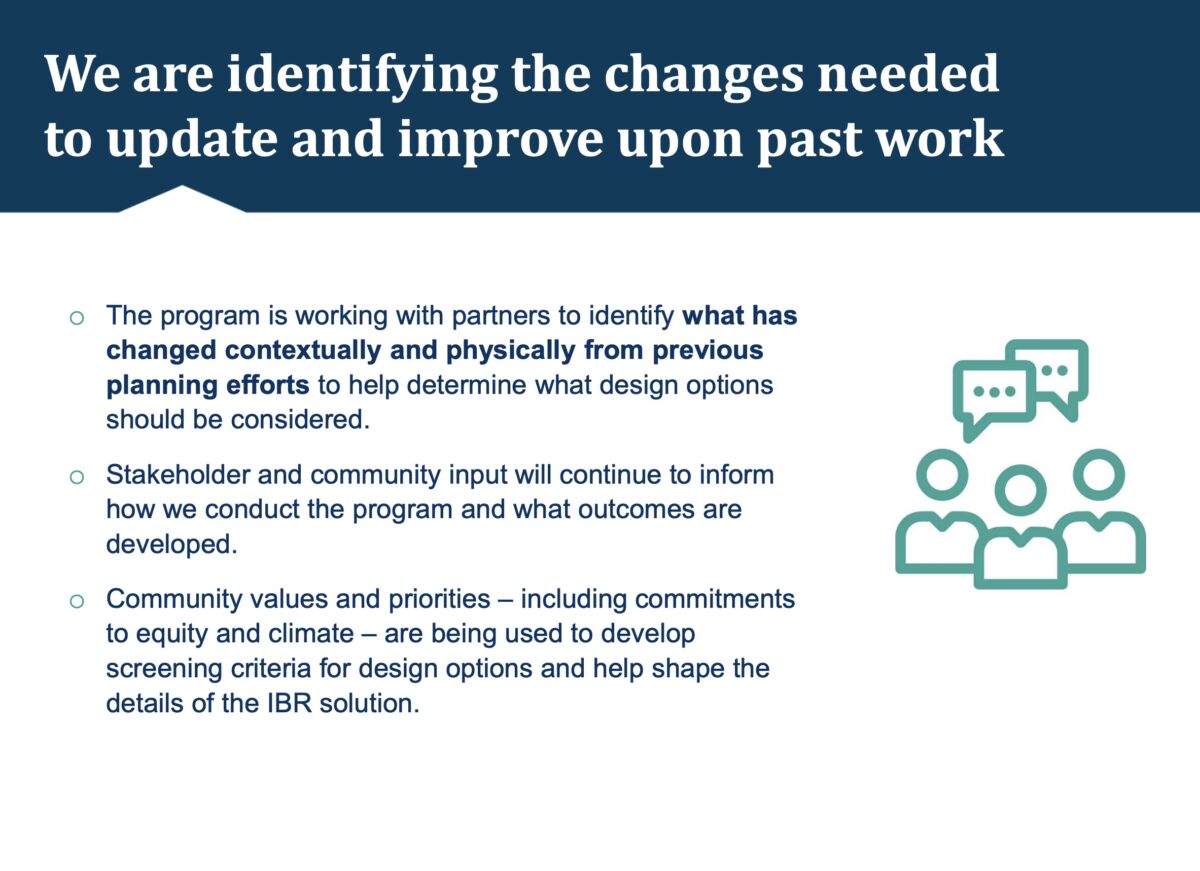
(Photo: Jonathan Maus/BikePortland)
Ryan Packer is our special correspondent for the Interstate Bridge Replacement project. See their past coverage here.
“We’re in a really critical moment with this project.”
— Brett Morgan, 1000 Friends of Oregon
As a small number of Portland-area elected officials push a design option for I-5 over the Columbia River that doesn’t expand the highway to ten lanes, a broad group of environmental and sustainable transportation organizations have signed a letter that supports them. At the same time, an advisory committee at Metro has unanimously supported an additional $71 million to continue planning the project, teeing up a major showdown next month.
The letter (PDF), signed by sixteen orgs including Oregon League of Conservation Voters, Climate Solutions, the Street Trust, and Oregon Walks, sent to the Interstate Bridge Replacement (IBR) project team on Monday, spells out that a climate-forward project means “[t]he IBR must not expand the number of vehicle travel lanes, including auxiliary lanes”, and pushes for updated models before moving forward with a set number of design options.
“The IBR project must prioritize the efficient movement of goods and people: by moving more people across the bridge, via transit and safe and accessible active transportation options, while moving the same or fewer cars (via pricing) and providing freight priority,” the letter states.
This letter follows one sent on October 21 (PDF) signed by Portland Transportation Commissioner Jo Ann Hardesty and Metro President Lynn Peterson that gets in writing the request that those two elected officials made of the IBR project team during their last Executive Steering Group meeting. “We need to see analysis that looks at what is possible if we fully invest in transit capacity and access and integrate equitable congestion pricing,” the letter states.
That Hardesty/Pederson letter notes that “some significant base assumptions have not been adequately revisited” from the CRC project a decade ago, and notes concerns “that under the current work plan, elements will only be analyzed individually as if they do not influence each other (i.e., highway design, tolling, and transit options).”
Advertisement
“We’re in a really critical moment with this project,” 1000 Friends of Oregon Policy Manager Brett Morgan, a signatory and primary force behind the sign-on letter released Monday, told BikePortland. With the MTIP project selection and funding process proceeding at Metro, he said, “there are more reasons to have more attention on this project than ever.” Morgan added that the letter represents a “common ground for partners to become more engaged on the project” as details around the project have become increasingly clear.
Statewide land-use nonprofit 1000 Friends of Oregon has also published their own thoughts on the project via a blog post titled “The Interstate Bridge Replacement Project is an equity and climate disaster”, and they are not alone in asking the Metro Council to put the brakes on the IBR project. Today, No More Freeways launched a new campaign asking Metro to withhold funding until the project team presents a more climate-friendly version of the project.




Right now, momentum is with the project. At their November 5th meeting, the Metro Transportation Policy Alternatives Committee (TPAC) voted unanimously to release an additional $71 million in planning and engineering funds for the IBR ($36 million from Oregon, $35 from Washington). Metro does not have a voting member on that board, and Portland’s representative, PBOT regional planner Eric Hesse, was not present. That vote is the first approval on its way to a full vote of the Metro Council on December 2. During the TPAC meeting, multiple committee members framed a vote to release funds for engineering as necessary to determine answers to key questions that remain about the project.
“What we are trying to do is… keep traffic moving through to limit greenhouse gas from inefficient idling due to being stalled in traffic.”
— Raymond Maybe, ODOT
ODOT Deputy IBR Program Administrator Raymond Maybe told TPAC in a presentation prior to their vote that, “This [$71 million] covers the work to answer a lot of questions that our partners are asking… these funds help will help us work forward to address the questions and answers and address those concerns as we move forward.” Maybe also acknowledged that the project is looking to reconfigure seven interchanges across a five-mile section of I-5 and that one of the goals is to, “Keep traffic moving through to limit greenhouse gases from inefficient idling due to being stalled in traffic.” (This idea is controversial to say the least, but it’s a fundamental principle at ODOT that’s been espoused by Director Kris Strickler and Oregon Senator and Joint Transportation Committee Co-chair Lee Beyer.)
The IBR program has already spent millions on PR and outreach, but it remains to be seen how much that outreach process is operating in good faith. A central piece of their community engagement strategy are advisory boards, like the Community Advisory Group (CAG) and the Equity Advisory Group. But elected leaders on the Executive Steering Group saw the “universe” of design options before either advisory group did, and when the CAG was briefed on the design options last week, the request from Hardesty and Peterson for an additional option based on transit and congestion pricing was not brought up.
Program Administrator Greg Johnson told the CAG at their most recent meeting that elected leaders had not removed any options for their consideration, even as he omitted issues raised by those elected officials. “They wanted you to see everything, all the work that was done…you will be seeing all that work in total”, he told the group. Also at the meeting, Diana Nunez of the Oregon Environmental Council asked about data around impact of tolling and demand management. “In 2022 we’ll have a lot more information about tolling’s effect on the corridor and what that means,” was the response from Brad Philips of the IBR design team, but it’s not clear that any options with fewer than ten lanes will be advanced to the screening stage without all advisory boards pushing for it.
“While there are focus groups and engagement committees, the process that IBR project leadership has defined is confusing, and makes it hard for stakeholders to understand where meaningful opportunities to engage are and how their input will be integrated in the bridge,” the letter from advocacy groups noted.
With so many groups coming together to note where the project is falling short, this represents a key moment so far in the history of the CRC 2.0. What remains to be seen next is whether these voices for change are any match for the institutional inertia behind this mega-project.

